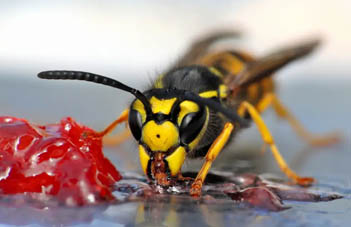
Everything that buzzes around your garden is potentially a pollinator. These fascinating insects are incredibly useful; not just in the garden, but also in agriculture, with many crops dependent on pollination.
There are thousands of species of buzzing insects, and the majority are not classed as a pest. And while you might see headlines about the ‘murder hornet’ you’re almost definitely not going to see one in your back garden. But some wasps and hornets can be a public health risk if they are in the wrong place. This handy guide helps you identify if your buzzing visitors are a pest and whether you should call in professional help.
Treating a wasp nest can be very dangerous. Wasps inside the nest will feel threatened and often become aggressive. This could cause them to sting you and others as they defend their nest resulting in multiple stings. Unlike bees, wasps do not die after one sting, they can, and will, sting you quite a few times! These two species are almost identical, but you can tell them apart by their facial and thorax markings. Common wasps generally have an ‘anchor’ shaped black marking on the front of their face, while German wasps have either an incomplete version of this, or three distinctive black dots on yellow. Both species are social and have a single queen who produces 3,000 to 8,000 workers. They make football-sized nests in the ground or in roofs and trees, which they abandon after the summer and don’t return to the following year.
Twice the size of a wasp with brown and yellow markings, the European Hornet is not a common sight. They only occasionally enter houses so if there is increased hornet activity around your home or business, call a professional pest controller for advice. Black or dark brown, key features are a distinct yellow band at the rear, a fine, bright yellow ‘belt’ at the waist and a black head with orange or yellow face. Asian hornets have been seen in Britain since 2016 and are an invasive predatory species that could have a devastating impact on British wildlife. They’re slightly smaller than our native hornets and have a dark abdomen and a fourth yellow segment. Another way to tell the difference is that Asian hornets have bright yellow tips to the legs while our native hornets have dark legs.
There are approximately 9,000 species of wasp in the UK, and most never come into conflict with humans! Red wasps can be identified by the red tinge on their abdomens. They are a social species that build small nests underground. A single queen will produce around 300 workers. Saxon wasps can be spotted by the single yellow line running from behind the head to each wing. They do not become violent unless their nest is threatened. Tree wasps are a medium-sized wasp with conspicuous long hairs on the face and head as well as a completely black mid-section. Not usually a problem around humans, with no interest in entering buildings or human food, it can sting if the nest is threatened.

Call 08455 192 486 today to arrange a no obligation survey of your bird or pest control infestation.